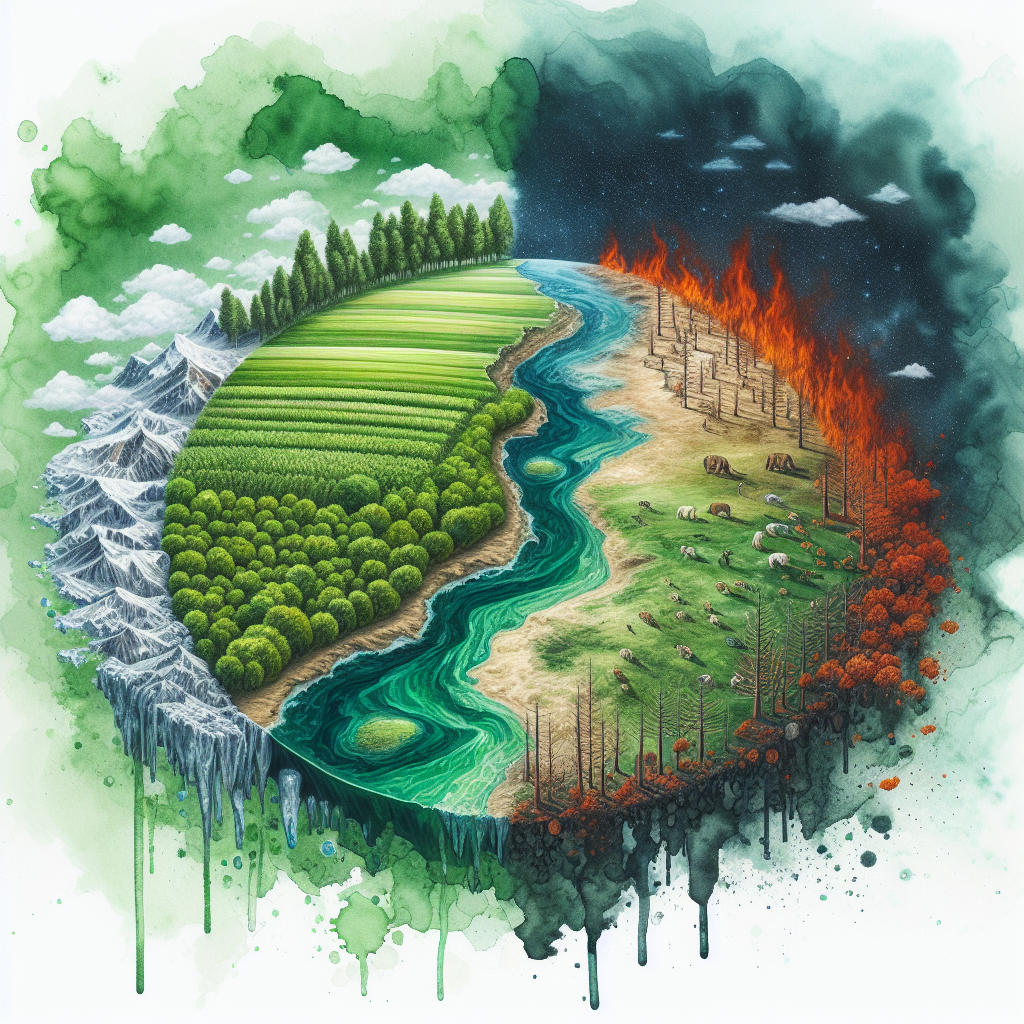Introduction
Climate change is no longer a distant threat looming on the horizon; it is an urgent crisis unfolding before our eyes. With each passing year, the evidence of its impacts becomes starker and more undeniable. From extreme weather events to rising sea levels, the signs of a planet in distress are all around us. In this comprehensive exploration, we will delve into the intricacies of climate change: its causes, consequences, and the imperative for collective action to mitigate its effects.
Understanding Climate Change: Causes and Mechanisms
At its core, climate change refers to long-term alterations in temperature and weather patterns on Earth. While natural factors like volcanic eruptions and variations in solar radiation have historically influenced climate, the primary driver of contemporary climate change is unequivocally human activity. The combustion of fossil fuels—coal, oil, and natural gas—for energy production, transportation, and industrial processes releases vast quantities of greenhouse gases (GHGs) into the atmosphere.
These greenhouse gases, including carbon dioxide (CO2), methane (CH4), and nitrous oxide (N2O), act like a blanket, trapping heat and causing the planet to warm—a phenomenon known as the greenhouse effect. The concentration of CO2 in the atmosphere has increased by more than 40% since the Industrial Revolution, primarily due to the burning of fossil fuels and deforestation, disrupting the delicate balance of Earth’s climate system.
Consequences of Climate Change: Environmental, Social, and Economic Impacts
The impacts of climate change are wide-ranging and profound, affecting ecosystems, economies, and societies across the globe. One of the most visible consequences is the rise in global temperatures, leading to melting ice caps and glaciers. As ice melts, sea levels rise, threatening coastal communities and low-lying areas with inundation and erosion. Small island nations are particularly vulnerable, facing the existential threat of being swallowed by the sea.
Extreme weather events, including hurricanes, droughts, heatwaves, and wildfires, have become more frequent and intense in a warming world. These events wreak havoc on communities, causing loss of life, displacement, and widespread destruction of property and infrastructure. The 2021 Intergovernmental Panel on Climate Change (IPCC) report warned of escalating risks, stating that “every increment of global warming matters.”
Moreover, climate change exacerbates existing environmental challenges, such as biodiversity loss and ecosystem degradation. Species are facing extinction at an alarming rate as habitats shift and degrade due to changing climatic conditions. Coral reefs, often referred to as the “rainforests of the sea,” are under threat from ocean warming and acidification, endangering marine biodiversity and the livelihoods of millions of people who depend on reef ecosystems for food and income.
In addition to its environmental impacts, climate change amplifies social and economic inequalities, disproportionately affecting vulnerable populations. Indigenous communities, for example, are on the front lines of climate change, facing the loss of traditional lands, cultural heritage, and livelihoods due to environmental disruptions. Moreover, marginalized communities, including the poor, elderly, and people with disabilities, are disproportionately impacted by extreme weather events and climate-related disasters, exacerbating existing disparities and injustices.
Economically, climate change poses significant risks, disrupting supply chains, increasing insurance costs, and reducing agricultural productivity. According to a report by the World Bank, climate change could push over 100 million people into poverty by 2030 if left unchecked, exacerbating global inequality and instability.
Mitigation and Adaptation: Strategies for Addressing Climate Change
Addressing climate change requires a multifaceted approach that encompasses both mitigation and adaptation strategies. Mitigation involves reducing greenhouse gas emissions to limit the extent of climate change, while adaptation aims to minimize its impacts and build resilience to its effects.
Mitigation efforts range from transitioning to renewable energy sources like solar and wind power to improving energy efficiency in buildings, transportation, and industry. Policymakers play a crucial role in implementing regulations and incentives to accelerate the transition to a low-carbon economy. The Paris Agreement, adopted in 2015 by nearly every country in the world, sets targets for limiting global warming and provides a framework for international cooperation on climate action.
Additionally, nature-based solutions, such as reforestation, afforestation, and sustainable land management, can help sequester carbon dioxide from the atmosphere and enhance ecosystem resilience to climate change. Protecting and restoring natural habitats, including forests, wetlands, and mangroves, not only mitigates climate change but also provides numerous co-benefits, such as biodiversity conservation, water purification, and flood mitigation.
Adaptation measures are equally vital for building resilience to the impacts of climate change, particularly for vulnerable communities and ecosystems. Investing in climate-resilient infrastructure, such as seawalls, stormwater management systems, and early warning systems, can reduce the risk of damage from extreme weather events and sea-level rise. Furthermore, integrating climate considerations into urban planning, agriculture, and water management can help communities adapt to changing climatic conditions and protect livelihoods.
The Role of Individuals and Communities: Driving Change from the Ground Up
While governments, businesses, and international organizations play a critical role in addressing climate change, individuals and communities also have the power to drive change from the ground up. Adopting sustainable practices in our daily lives, such as reducing energy consumption, minimizing waste, and supporting local and organic food production, can collectively make a significant impact on reducing carbon emissions and mitigating climate change.
Moreover, individuals can use their voices and influence to advocate for climate action and hold policymakers and corporations accountable for their commitments to sustainability. Participating in protests, signing petitions, and engaging in dialogue with elected officials are powerful ways to demand bold and equitable climate policies that prioritize environmental justice and human rights.
Community-led initiatives and grassroots movements also play a crucial role in raising awareness about climate change and mobilizing action at the local level. From community gardens and renewable energy cooperatives to climate resilience workshops and educational campaigns, these efforts empower communities to take ownership of their futures and build resilience in the face of climate change.
Conclusion: A Call to Action
In conclusion, climate change represents an existential threat that requires urgent and concerted action from all sectors of society. The time for debate and delay is over; we must act decisively to curb greenhouse gas emissions, adapt to changing climatic conditions, and protect vulnerable communities and ecosystems from the impacts of climate change.
As we confront the challenges of climate change, we must prioritize equity, justice, and solidarity to ensure a sustainable and liveable future for all. By embracing the imperative for change and working together across borders and boundaries, we can forge a path towards a more resilient, equitable, and sustainable world for current and future generations.
Now is the time for bold commitments, innovative solutions, and collective determination to address the defining issue of our time. Let us rise to the challenge of climate change with courage, compassion, and resolve, knowing that the future of our planet—and all its inhabitants—hangs in the balance.








Leave a Reply